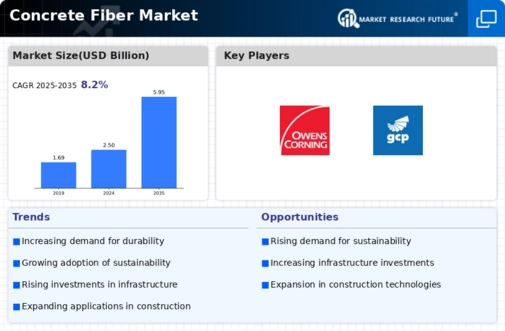Top Industry Leaders in the Concrete Fiber Market
The global concrete fiber market boasts a dynamic growth is fueled by the construction boom, particularly in Asia-Pacific and North America, where infrastructure development and an emphasis on sustainable construction reign supreme. This vibrancy, however, translates to a fiercely competitive landscape, with players employing diverse strategies to gain a foothold.
Strategic Maneuvers for Market Share Dominance:
-
Product Diversification: Leading players like Bekaert, Saint-Gobain Weber, and Nyfil are expanding their portfolios beyond traditional synthetic fibers. Basalt fibers, with their superior fire resistance and strength, are gaining traction, while research into eco-friendly options like natural fibers is on the rise. -
Regional Focus: Companies are tailoring their offerings to specific regional needs. For instance, in Asia-Pacific, cost-effective polypropylene fibers are popular, while North America sees a higher demand for high-performance carbon fibers. -
Technological Advancements: Innovation is key, with continuous improvements in fiber design, manufacturing processes, and application techniques. Fiber manufacturers are collaborating with universities and research institutions to develop next-generation solutions, like smart fibers embedded with sensors for real-time monitoring of concrete structures. -
Sustainability Drive: Environmental concerns are pushing manufacturers to adopt sustainable practices. Recycled fibers and bio-based options are gaining favor, driven by regulations and rising consumer demand for green buildings. -
Vertical Integration: Some players are pursuing vertical integration, acquiring mines for raw materials and expanding into concrete production. This ensures control over quality and cost, offering a competitive edge.
Determinants of Market Share:
-
Brand Reputation and Expertise: Established players with proven track records and extensive technical expertise hold an advantage. Bekaert, with its 130-year history of innovation, and Saint-Gobain Weber, known for its high-performance products, are prime examples. -
Geographical Presence and Distribution Network: A strong global footprint and efficient distribution channels are crucial for reaching diverse markets. Manufacturers like Nyfil, with its presence in over 60 countries, demonstrate this advantage. -
Cost-Effectiveness and Price Competitiveness: Balancing quality with affordability is essential, particularly in price-sensitive markets. Companies like Sika and Euclid Chemical offer a range of fibers catering to different budget constraints. -
Customer Relationships and Services: Building strong relationships with architects, engineers, and contractors is key. Providing technical support, training programs, and customized solutions fosters loyalty and drives repeat business. -
Regulatory Compliance and Quality Certifications: Adherence to stringent safety and environmental regulations is paramount. Obtaining certifications like CE marking and ISO standards instills trust and opens doors to new markets.
Key Players
BASF SE of Germany,
Nyon,
The Euclid Chemical Company,
Owens Corning of United States,
Sika AG of Switzerland,
Bosfa,
Propex Operating Company LLC of United States,
ABC Polymer Industries LLC of United States,
Helix Steel Dow,
GCP Applied Technologies Inc
Recent Developments :
September 2023: A major infrastructure project in India mandates the use of basalt fibers for all concrete structures, highlighting the growing popularity of this alternative fiber.
October 2023: Researchers develop a new method for embedding sensors within concrete fibers, paving the way for real-time monitoring of concrete structures and predictive maintenance.
November 2023: The American Concrete Institute updates its specifications for concrete fiber-reinforced pavements, opening up new opportunities for fiber manufacturers in the transportation sector.
December 2023: A consortium of leading concrete fiber manufacturers launches a joint research initiative to develop the next generation of high-performance, sustainable concrete fibers.
